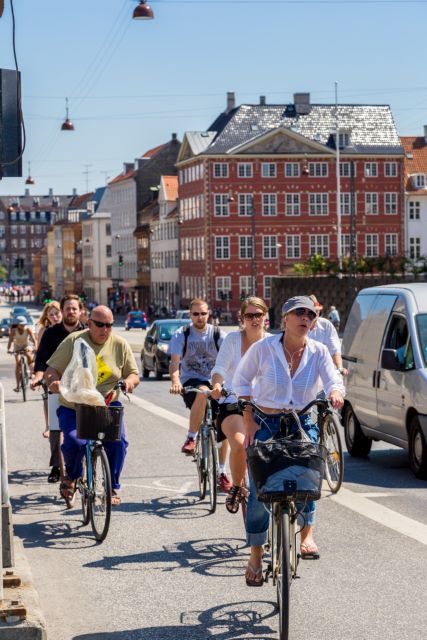 Life & Style
Life & Style

On the occasion of the Danish Constitution Day, Denmark’s Ambassador to Việt Nam Kim Hojlund Christensen writes to Việt Nam News about the green aspirations and relations between two countries.

|
| Copenhagen, Denmark’s capital city, is one of the most bicycle friendly cities in the world. Photo courtesy of the embassy |
Danes around the world are gearing up to celebrate our nation’s Constitution Day (June 5) with patriotic displays, political debates and family events. Actually, this year it is also election day. The Constitution defines how Denmark is governed. To many of us, Constitution Day is also a day to commemorate Denmark’s achievements through the years as results of its firm belief in principles like putting people at the centre of development and economic policies, preserving the global ecosystem for future generations and keeping the planet’s survival in mind.
For many countries, creating a richer life for their citizens involves higher growth rates with more cars, taller buildings and more consumer goods. Many Danes, however, find that more is not necessarily better. Gone are the days of fascination with fast GDP expansion without critical reflection about growth’s negative impacts like environmental pollution, a global ecosystem thrown-off balance or a bigger inequality gap. Switching to a path of sustainable, harmonious economic growth is currently a major priority for a significant part of the Danish population, and is reflected in the day-to-day behaviour of the Danes.
Meanwhile, Việt Nam has recently developed into a middle-income country with a market-driven economy and fast increases in wealth, rising sales of consumer goods and an overheating real estate market. In step with increasing living standards, the Government of Việt Nam has also highlighted worrying signs to the environment – for example waste growth, big city congestion, heavy weight of raw-material and energy-intensive sectors. Emissions of greenhouse gas and toxic substances are also on the rise. As Denmark has a long history of addressing these issues and likes to think of itself at the vanguard when it comes to green initiatives, we are here to share expert knowledge to assist Việt Nam find sustainable solutions.
Denmark has supported the Việt Nam National Target Programme to respond to climate change and the Việt Nam Energy Efficiency Programme since 2012. Up to 2014, we were the leading donor to Việt Nam in these areas and allocated US$22.5 million in development aid to the two programmes.
Another evidence of our co-operation on green growth is the Vietnamese engagement in the Danish initiative Partnering for Green Growth and the Global Goals 2030 (P4G). Prime Minister Nguyễn Xuân Phúc’s participation in the first P4G Summit in Copenhagen last October and the establishment of a Vietnamese National P4G Platform in July last year were yet more signs of the Vietnamese commitment to be active on this agenda.
In the Comprehensive Partnership Agreement between our two countries signed in 2013, energy is a particularly important area of co-operation. During the last decades, the rapid growth of Việt Nam’s economy with a heavy weight of raw-materials and energy-intensive sectors has manifested itself in rising energy consumption.
The challenge is how to create a green, reliable and competitive energy system that meets the future energy needs for economic development at an affordable cost, yet reducing carbon emissions at the same time. In the 1970s Denmark was severely hit by the oil crises. Learning the lesson, our country has worked hard to become independent of fossil fuel and achieve economic growth without increasing its energy consumption. Denmark wants to share the lessons learned throughout our energy transition process with Việt Nam.
To deploy carbon-off setting opportunities and reduce costs in energy systems in Việt Nam, we agreed on a new Danish Energy Partnership Programme 2017-2020 (DEPP) to kick off a new phase of energy co-operation with a budget of approximately US$3.3 million. This partnership aims at assisting Việt Nam to create long-term policies to include more renewable energy in the energy mix, to save significant amounts of power in production and at the same time to increase its energy security. In other words, we are working with Việt Nam to analyse the options for integrating renewable energy sources into its power system and gradually phasing out coal-fired power plants.
The results of our work show that it is feasible for Việt Nam to achieve its target, which includes successfully integrating a 43 per cent share of renewable energy such as solar and wind into its power system by 2030 and obtaining a 50 per cent share by 2050. Wind and solar energy are local and carbon-emission free energy sources, which neither cause air pollution nor require reliance on fuel imports and exposure to the volatile international coal and gas markets like conventional power plants. In Denmark windmills already produce more than 40 per cent of the total electricity consumption in the country. With a 3,000km coastline and located in the monsoonal climate zone, the future of renewable energy in Việt Nam could be bright, especially when it comes to wind power.
We are delighted to know that Việt Nam is trying to raise the ratio of renewable energy in its energy mix with recent policy movements, like the increase in feed-in-tariffs for solar energy and more bankable power purchase agreements. This shows your country’s desire to adopt a greener energy path, but there are still obstacles to the development of wind energy in Việt Nam. The current power purchase agreement is not bankable from international investors’ point of view as EVN has the option to withdraw from it anytime. This creates a lot of uncertainty from the point of view of an international investor. This is especially a challenge when it comes to offshore wind where even small projects cost $600- 700 million.
Even though the cost of renewable energy is decreasing, obtaining a larger share requires substantial investment. These costs could be reduced significantly if Việt Nam focuses on using energy more efficiently. That is why Denmark is co-operating with Việt Nam to improve energy efficiency in industrial processes and within the building sector. Efficient use of energy is the most cost-effective method to improve energy security while reducing emissions as well as air pollution. It makes the energy system cheaper, the industry stronger and together with renewable energy creates a sustainable society with little or no extra cost.
Saving energy is, however, also the responsibility of every citizen. In Denmark we teach our children to turn off the lights when they leave a room, and to use electrical appliances only when necessary and in a thoughtful and environmentally responsible way: you do not need to have wifi turned on while you are sleeping and you should not have air conditioners turned on if your windows are open. More and more countries are discovering that the safest and cleanest power plants are the ones you don’t have to build thanks to everyone’s efforts to save energy and higher energy efficiency. Money saved is money that can be spent on something else – for instance on improving the healthcare system to the benefit of all citizens.
To wrap up, I would like to share with you another secret to Danish happiness. Danes, often hailed as some of the happiest people on Earth, love nothing more than a green way of living. We are cycling and recycling fanatics. We are living in cities where cars are becoming irrelevant and pedestrians, cyclists and street life are paramount. Danish architects like Jan Gehl are famous across the globe for making cities for people. Two of his books were recently translated into Vietnamese and were enthusiastically received by readers here. Green-living is implanted in the cultural DNA of the Danes. We've learned that those who engage in pro-environmental behaviour tend to be happier and we hope this living philosophy can be adopted by Việt Nam and its people. VNS



.jpg)
